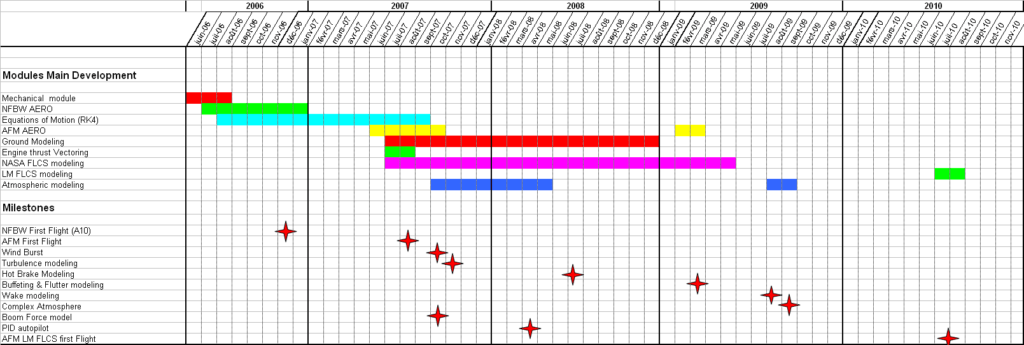1. Introduction
As seen in the Developer’s Note #4, the FLCS of the AFM was based on the NASA Technical Paper 1538 (TP 1538 ) “Simulator Study of Stall / Post Stall Characteristics of a Fighter Airplane with Relaxed Longitudinal Static Stability”.
I will reference this FLCS model as the “NASA FLCS”.
The NASA FLCS was well detailed for the Cruise gains, but did not describe the Takeoff and Landing Gains nor the Ground Gains at all. These gains were created from scratch from the different descriptions available in the different F-16 manuals.
After 1 year of testing, the NASA FLCS was polished enough for a release and yielded very good results. The model was tested by several real F-16 pilots and they all confirmed that the model was excellent.
However, some small details were still hitching my disturbed mind!
2. Criticism of the NASA FLCS model
The NASA FLCS model was suffering from several small issues:
In Cruise Gains:
- The pitch response seemed less “snappy” than the real aircraft (as observed from various airshow maneuver HUD tapes),
- The G’s build up was not as quick as the real aircraft in the 8-9 G area,
- Maximum G could not be reached in MIL conditions,
- Some Push down was needed more than the real aircraft to “freeze the nose”.
In Takeoff and Landing Gains:
- The AOA blending was excessive resulting in an abnormal push down effect when AOA was high,
- There was a small discontinuity between Cruise Gains and Landing Gains (even if it was masked for the player).
In Ground Gains:
- The elevators were not moving while taxiing and bumping,
- The roll off was difficult to control with nose high,
- The reaction of the model was exaggerated during cross wind take off.
3. A new FLCS mode
In Mid-2009 I found on the web a complete set of Control Law Functional Block Diagrams for the F-16.
My first reaction was to compare the NASA FLCS model with this one and my conclusion was that the NASA model was 95% the same for the Cruise Gains.
Those new functional block diagrams had the Takeoff and Landing Gains, the Ground Gains and the Standby gains fully integrated in the diagram. However, as they were integrated in the diagram in an analog way, I was unable to tell if the model I created on top of the NASA FLCS for LG and GG was accurate or not.
Mid-2010, I had a deeper look at this document and I found one difference in the Cruise Gain model that could explain the “issues” we had in pitch response…
The Elevator Command Proportional Integrator was slightly different than the NASA one….
On top of that the Takeoff and Landing Gains and Ground Gains were not that complicated to implement in the overall scheme.
August 2010, as release was delayed because of other parts of the code, I decided then to try to fully code this FLCS model and compare it with the NASA one. Amazingly, as the models were VERY similar, it took me only a few hours to code it. My goal was not to implement this model for the release (as the release was close), but it was more for the beauty of it.
The other parameter that pushed me to do it is quite personal, let me digress here.
What I liked the most after those 4 years of development is when I had finished the code and I tried to takeoff the plane for the first time. At that moment, believe me, I felt like a test pilot, what will happen? Will it fly?
I had lived this moment twice in the BMS FM development, the first one was for the first A-10 – NFBW flight, the other one was for the AFM – F-16 first flight. Now that was the opportunity to do it again.
So I launched the mission on taxi. While taxiing, I first had a look on the elevators, yeaaaaah they are now moving like in the videos, some stick input…ok, everything seems normal and surfaces are back on normal position when stick released….good sign….
Time to accelerate…I will try to move the stick up and down during acceleration and watch the nose moving up and down…everything is okay…150kt…I pull back on the stick….the nose comes up….takeoff….here I know that the FLCS is switching from Ground Gains to Landing Gains as the WOW is off….I expect an instability or a crash…nothing…the model starts to climb and seems to respond nicely to my stick input… small input left, right, it seems ok….
Let’s try to raise up the gear now, again, the FLCS switches from Landing Gains to Cruise Gains….nice…..no weird transition…everything is flying smooth…some maneuvers…..big smile on my face, I can feel the difference, model is more snappy in pitch, some roll tests….seems ok, time to come back to the base….Landing Gains …transition smooth! The model now requires less stick back pressure during landing….touch down….the nose feels heavier, it is still difficult (at least different) to control aero breaking. Some tweaking on gear position will likely be required.
What a BLAST! After my first flight, the FLCS responded very nicely….so nicely that it took me only a few hours to squash the remaining bugs and after a few hours more of testing I decided that I wanted this FLCS to make the release.
4. Conclusion
August 2010, that was the end of the BMS – FM development for me. It took me 5 years of work to accomplish this and despite the thousands of hours spent, despite the sleepless nights, nothing could replace the smile I had during that last first flight and I hope you will have the same smile when you make your first take off with the BMS Viper…and that this smile will remain on your face for a long time.
Long live BMS.
-Mav-jp


